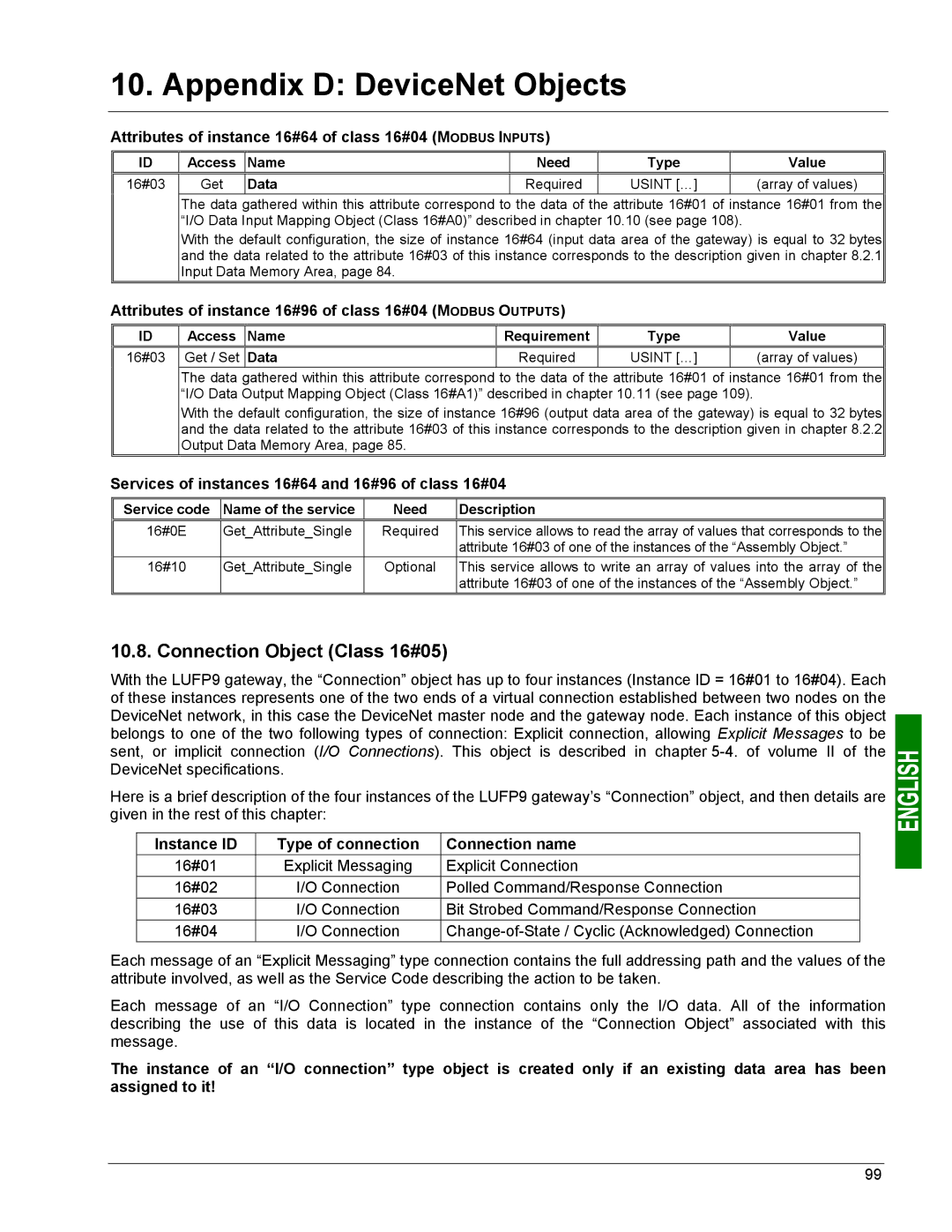
10. Appendix D: DeviceNet Objects
Attributes of instance 16#64 of class 16#04 (MODBUS INPUTS)
ID | Access | Name | Need | Type | Value |
16#03 | Get | Data | Required | USINT […] | (array of values) |
The data gathered within this attribute correspond to the data of the attribute 16#01 of instance 16#01 from the “I/O Data Input Mapping Object (Class 16#A0)” described in chapter 10.10 (see page 108).
With the default configuration, the size of instance 16#64 (input data area of the gateway) is equal to 32 bytes and the data related to the attribute 16#03 of this instance corresponds to the description given in chapter 8.2.1 Input Data Memory Area, page 84.
Attributes of instance 16#96 of class 16#04 (MODBUS OUTPUTS)
ID | Access | Name | Requirement | Type | Value |
16#03 | Get / Set | Data | Required | USINT […] | (array of values) |
The data gathered within this attribute correspond to the data of the attribute 16#01 of instance 16#01 from the “I/O Data Output Mapping Object (Class 16#A1)” described in chapter 10.11 (see page 109).
With the default configuration, the size of instance 16#96 (output data area of the gateway) is equal to 32 bytes and the data related to the attribute 16#03 of this instance corresponds to the description given in chapter 8.2.2 Output Data Memory Area, page 85.
Services of instances 16#64 and 16#96 of class 16#04
Service code | Name of the service | Need | Description |
16#0E | Get_Attribute_Single | Required | This service allows to read the array of values that corresponds to the |
|
|
| attribute 16#03 of one of the instances of the “Assembly Object.” |
16#10 | Get_Attribute_Single | Optional | This service allows to write an array of values into the array of the |
|
|
| attribute 16#03 of one of the instances of the “Assembly Object.” |
10.8. Connection Object (Class 16#05)
With the LUFP9 gateway, the “Connection” object has up to four instances (Instance ID = 16#01 to 16#04). Each of these instances represents one of the two ends of a virtual connection established between two nodes on the DeviceNet network, in this case the DeviceNet master node and the gateway node. Each instance of this object belongs to one of the two following types of connection: Explicit connection, allowing Explicit Messages to be sent, or implicit connection (I/O Connections). This object is described in chapter
Here is a brief description of the four instances of the LUFP9 gateway’s “Connection” object, and then details are given in the rest of this chapter:
Instance ID | Type of connection | Connection name |
16#01 | Explicit Messaging | Explicit Connection |
16#02 | I/O Connection | Polled Command/Response Connection |
16#03 | I/O Connection | Bit Strobed Command/Response Connection |
16#04 | I/O Connection |
Each message of an “Explicit Messaging” type connection contains the full addressing path and the values of the attribute involved, as well as the Service Code describing the action to be taken.
Each message of an “I/O Connection” type connection contains only the I/O data. All of the information describing the use of this data is located in the instance of the “Connection Object” associated with this message.
The instance of an “I/O connection” type object is created only if an existing data area has been assigned to it!
99
